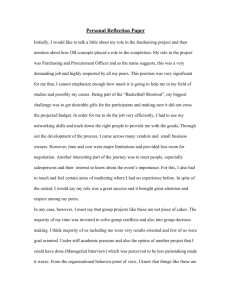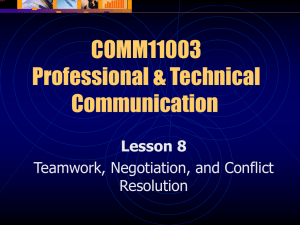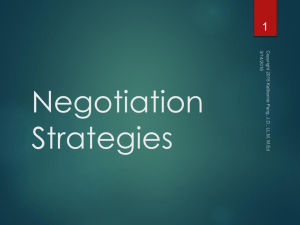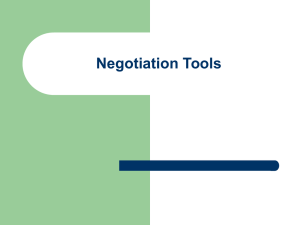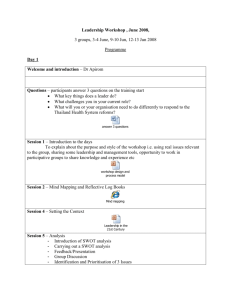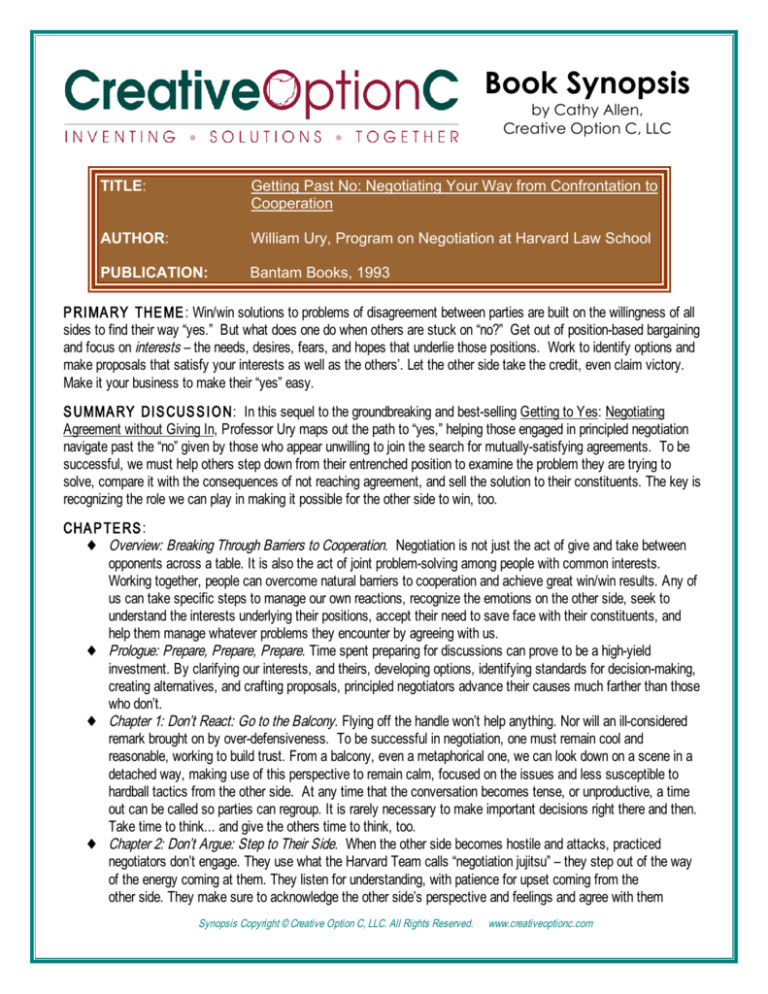
Book Synopsis
by Cathy Allen,
Creative Option C, LLC
TITLE:
Getting Past No: Negotiating Your Way from Confrontation to
Cooperation
AUTHOR:
William Ury, Program on Negotiation at Harvard Law School
PUBLICATION:
Bantam Books, 1993
P RI MA RY THE ME : Win/win solutions to problems of disagreement between parties are built on the willingness of all
sides to find their way “yes.” But what does one do when others are stuck on “no?” Get out of position-based bargaining
and focus on interests – the needs, desires, fears, and hopes that underlie those positions. Work to identify options and
make proposals that satisfy your interests as well as the others’. Let the other side take the credit, even claim victory.
Make it your business to make their “yes” easy.
S UMMA RY DI S CUS S I O N: In this sequel to the groundbreaking and best-selling Getting to Yes: Negotiating
Agreement without Giving In, Professor Ury maps out the path to “yes,” helping those engaged in principled negotiation
navigate past the “no” given by those who appear unwilling to join the search for mutually-satisfying agreements. To be
successful, we must help others step down from their entrenched position to examine the problem they are trying to
solve, compare it with the consequences of not reaching agreement, and sell the solution to their constituents. The key is
recognizing the role we can play in making it possible for the other side to win, too.
CHA P TE RS :
♦ Overview: Breaking Through Barriers to Cooperation. Negotiation is not just the act of give and take between
opponents across a table. It is also the act of joint problem-solving among people with common interests.
Working together, people can overcome natural barriers to cooperation and achieve great win/win results. Any of
us can take specific steps to manage our own reactions, recognize the emotions on the other side, seek to
understand the interests underlying their positions, accept their need to save face with their constituents, and
help them manage whatever problems they encounter by agreeing with us.
♦ Prologue: Prepare, Prepare, Prepare. Time spent preparing for discussions can prove to be a high-yield
investment. By clarifying our interests, and theirs, developing options, identifying standards for decision-making,
creating alternatives, and crafting proposals, principled negotiators advance their causes much farther than those
who don’t.
♦ Chapter 1: Don’t React: Go to the Balcony. Flying off the handle won’t help anything. Nor will an ill-considered
remark brought on by over-defensiveness. To be successful in negotiation, one must remain cool and
reasonable, working to build trust. From a balcony, even a metaphorical one, we can look down on a scene in a
detached way, making use of this perspective to remain calm, focused on the issues and less susceptible to
hardball tactics from the other side. At any time that the conversation becomes tense, or unproductive, a time
out can be called so parties can regroup. It is rarely necessary to make important decisions right there and then.
Take time to think... and give the others time to think, too.
♦ Chapter 2: Don’t Argue: Step to Their Side. When the other side becomes hostile and attacks, practiced
negotiators don’t engage. They use what the Harvard Team calls “negotiation jujitsu” – they step out of the way
of the energy coming at them. They listen for understanding, with patience for upset coming from the
other side. They make sure to acknowledge the other side’s perspective and feelings and agree with them
Synopsis Copyright © Creative Option C, LLC. All Rights Reserved.
www.creativeoptionc.com
♦
♦
♦
♦
where they can, without conceding their main point. When they do express your views, they do so with
confidence and avoid words they know will provoke a response. The way to the win/win is to “acknowledge the
other person’s views and stand up for your own.” Be optimistic.
Chapter 3: Don’t Reject: Reframe. Whenever the other side offers a proposal, we must resist all temptation to
dismiss it. Asking “help me understand the problem you are trying to solve” makes them a partner, rather than
an opponent. Other problem-solving questions include “Why?”, “Why not?”, “What if?”, and “What makes that
fair?” Hardball tactics can be reframed in a positive manner. If they stone wall, we can ignore it. If they attack us
personally, we can recast it as an attack on the problem. Turn past wrongs into future possibilities. Name a dirty
trick out loud, or play along as though they are negotiating in good faith, while continuing to ask clarifying
questions. Negotiate the negotiating process.
Chapter 4: Don’t Push: Build Them a Golden Bridge. Once a position has been taken, it can be very difficult to
change it, to risk being perceived as having backed down. This is true even when the agreement at hand is better
than all alternatives. A principled negotiator will assist their counterpart, help make it easy for them to accept the
proposal. Set up the opportunity for them to craft the win/win. Give them the credit. Whatever it takes.
Sometimes involving a neutral third party can be a big help. Mistakes happen in a rush, making implementation of
the final agreement more difficult. so take care at the end and make sure they understand the agreement the
same way you do.
Chapter 5: Don’t Escalate. There are consequences to not reaching agreement. To be successful, help the other
side see that it is easier to come to terms with you than to live with those consequences. Ask them about their
alternatives, especially if they seem unrealistic to you. Make sure they know your back up plan, but take care to
not be threatening as that can backfire. If you have power, use it minimally with an eye toward educating them
about the best path forward, rather than to force compliance. Sometimes what is obvious to us is not obvious to
others. If the deal is tenuous, build in a procedure for handling disputes when they arise, or plan for phases: as
they hold up part of their end, you hold up part of yours.
Conclusion: Turning Adversaries Into Partners. Principled negotiators respect their counterparts. The
breakthrough method of getting to win/win preserves the relationship. It is hard work, but worth it!
TOOLS:
♦ Appendix: Preparation Worksheet
KEY TAKEAWAYS: “Just as it takes two to tango, it takes two to tangle.” p. 37
“If you want them to listen to you, begin by listening to them. If you want them to acknowledge your point, acknowledge
theirs first. To get them to agree with you, begin by agreeing with them.” p. 54-55
“Only half the power of a problem-solving question lies in the question itself. The other half can be found in the pregnant
silence that follows as the other side struggles with the question and mulls over their answer. A common mistake is to
deprive them of this creative time... Let the silence and discomfort do their work.” p. 88-89
“Face-saving is at the core of the negotiation process... face is much more than ego. It is shorthand for people’s selfworth, their dignity, their sense of honor, their wish to act consistently with their principles and past statements - plus, of
course, their desire to look good to others.” p. 120
“To break the ice at the start of a tense negotiation, begin...with the issue that is easiest for you to agree on. By moving
progressively from the easier to the more difficult issues, you can get the other side into the habit of saying yes.” p. 126
“Your power to bring the other side to terms comes not from the costs you are able to impose but from the contrast
between the consequences of no agreement and the allure of the golden bridge.” p. 148
“The key mistake we make when we feel frustrated is to abandon the problem-solving game and turn to the power game
instead. p. 132”

